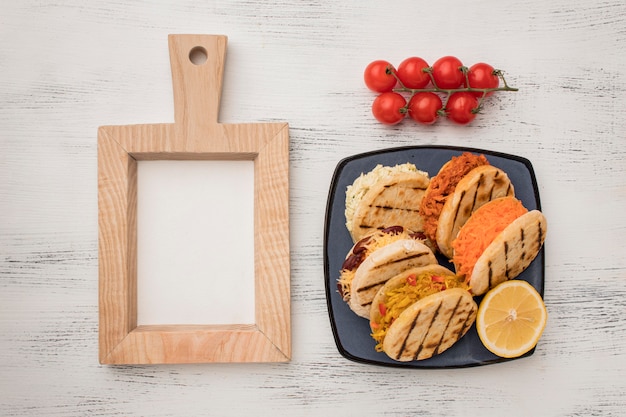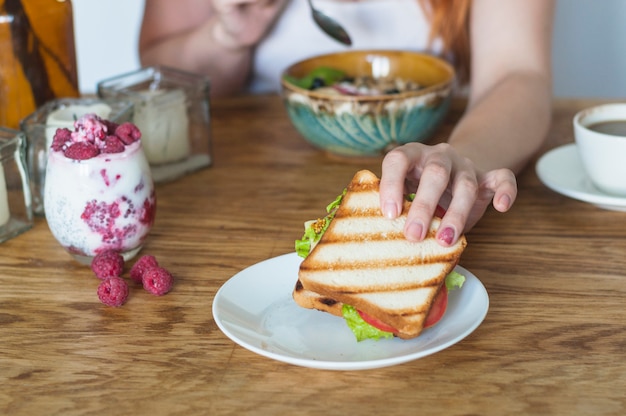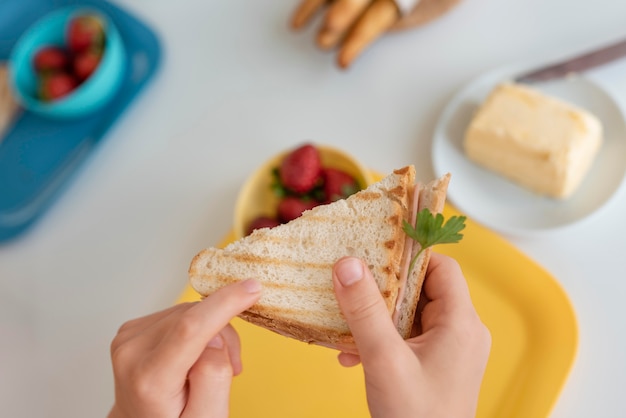Ah, Texas toast. The mere mention of those words conjures up images of crispy, golden-brown bread, generously slathered in butter, and baked to perfection. It's a classic comfort food that never fails to satisfy, and let's be honest, mastering the art of making the perfect Texas toast is a culinary quest worth undertaking.
I vividly recall my first attempt at crafting this buttery delight. I was so confident, so sure I could recreate that restaurant-worthy texture. But alas, my toast emerged pale, limp, and sadly lacking in the promised crunch. It was a culinary disaster, and I nearly gave up on the whole endeavor.
But then, my competitive spirit kicked in. I refused to let a soggy piece of toast defeat me! So, I embarked on a mission to decode the secrets of Texas toast perfection. Hours were spent researching techniques, testing different ovens, and trying out countless tips and tricks. And you know what? It was worth every minute. I finally cracked the code, and now, I can whip up flawless Texas toast every time.
So, gather your favorite bread, a generous pat of butter, and prepare to join me on this delicious culinary journey. I'm about to share everything I've learned about the perfect Texas toast cooking time, and by the end of this guide, you'll be a Texas toast maestro. Let's get started!
(Part 1) Unveiling the Magic of Texas Toast

Before we delve into the intricate details of cooking times, let's take a moment to appreciate the simple yet profound magic of Texas toast. What makes this humble bread creation so irresistible? Well, it's all about the perfect symphony of textures and flavors, crafted through a brilliant combination of thick-cut bread, generously applied butter, and a touch of oven magic.
Why Thick-Cut Bread is the Key
First, we have the bread. The foundation of any great Texas toast is a thick-cut slice of sturdy bread. Think of it as the canvas upon which we'll create a masterpiece of crispy, buttery goodness. Why thick-cut? Because thin slices simply don't have the structural integrity to withstand the butter and the heat of the oven. They'll become soft, flimsy, and ultimately, a disappointment. Thick-cut bread, on the other hand, provides the perfect base for achieving that irresistible crunch and satisfying chew.
Butter: The MVP of Flavor
Now, let's talk about the star of the show: the butter. This is where the magic truly begins. You need a generous amount of butter – not just a tiny dab – to create that beautiful golden-brown crust and that decadent, buttery flavor that makes Texas toast so addictive. Think of it as a luxurious, buttery coating, enveloping the bread and creating a symphony of textures and tastes. The key is to ensure the butter is evenly spread, reaching every nook and cranny of the bread slice. This will ensure a consistent, crispy texture throughout.
The Oven's Role in Transformation
Finally, the oven is the conductor of this culinary symphony, orchestrating the transformation of bread and butter into a masterpiece of Texas toast. The heat of the oven, combined with the butter, creates a beautiful caramelization process that produces that irresistible golden-brown color and the delightful crispy texture that defines Texas toast. The oven is the secret ingredient that brings everything together, transforming humble bread into a culinary delight.
(Part 2) Choosing Your Bread: The Foundation of Success

Our Texas toast journey begins with the bread, the very foundation upon which we will build our masterpiece. As we've already established, thick-cut bread is a must, but beyond that, the choice is yours. While classic white bread is the traditional choice, feel free to explore different bread options to discover your own perfect Texas toast experience.
Classic White Bread: The Tried and True
For those who crave the quintessential Texas toast experience, classic white bread is the way to go. Look for a loaf labeled "thick-cut" or "sandwich bread" to ensure you're working with a slice that can handle the butter and the oven's heat. This type of bread provides a neutral canvas for the butter and the oven to work their magic, resulting in a classic, satisfying Texas toast.
Whole Wheat: A Healthier Option
If you're looking for a slightly healthier option without sacrificing flavor or texture, whole wheat bread is an excellent choice. Choose a thick-cut loaf to avoid dryness, and you'll enjoy a hearty, nutty flavor and a good dose of fiber. Whole wheat bread adds a subtle complexity to the Texas toast experience, making it a satisfying and flavorful choice.
Sourdough: A Bold Choice for Adventurous Palates
For those who appreciate a touch of tang and a bolder flavor profile, sourdough bread can elevate your Texas toast to new heights. Sourdough's unique flavor, with its slightly acidic notes, pairs beautifully with the richness of butter. Just make sure you choose a loaf that's not too dense or chewy, ensuring it remains soft enough to absorb the butter and create that irresistible Texas toast texture. Sourdough adds a layer of sophistication to your Texas toast, making it a unique and flavorful treat.
(Part 3) The Butter: A culinary adventure in Flavor

With the bread chosen, we move on to the second star of the show: the butter. This is not just a supporting role; it's a crucial ingredient, responsible for both flavor and texture. The quality of your butter will directly impact the overall taste of your Texas toast, so choose wisely. Don't settle for cheap, overly processed butter; seek out a high-quality butter with a rich flavor that will complement your chosen bread.
Salted Butter: The Classic Choice for Savory Perfection
For those who prefer the traditional Texas toast experience, salted butter is the way to go. The subtle saltiness adds a savory dimension that balances the sweetness of the bread and the richness of the butter. It creates a harmonious flavor profile that's simply irresistible.
Unsalted Butter: A Customizable Option for Flavor Control
If you prefer to control the salt level and customize your Texas toast experience, unsalted butter is a great option. This allows you to add salt to your preference, ensuring a perfect balance of flavors. Remember to add a pinch of salt to your butter before spreading it on the bread to achieve that satisfying savory note.
Flavored Butters: A Culinary Adventure in Taste
For those who crave a touch of adventure and an extra layer of flavor, explore the world of flavored butters. Garlic butter, herb butter, honey butter – the options are endless. These flavorful additions can elevate your Texas toast from simple to extraordinary, adding unique and delicious dimensions to your culinary experience.
Table Butter vs. Stick Butter: What's the Difference?
You might be wondering about the difference between table butter and stick butter. Table butter, often softer and more spreadable, is commonly used for spreading on toast or sandwiches. Stick butter, on the other hand, is firmer and typically comes in a rectangular block, often used for baking or cooking.
For Texas toast, either table butter or stick butter will work. The key is to let the butter soften at room temperature for a few minutes before spreading. This will make it easier to spread evenly and ensure it absorbs into the bread, creating a smoother, more flavorful texture.
(Part 4) Spreading the Butter: A Skill to Master
Now that you've chosen your bread and butter, it's time to get your hands dirty, or rather, your butter knife dirty! This part of the Texas toast process is a bit of an art form, a skillful dance between generosity and precision. But fear not, with a little practice, you'll be spreading like a pro in no time.
The Generous Approach: More is More
Don't be shy with the butter. The goal is to generously coat the entire surface of your bread, creating a thick, even layer. Remember, the more butter you use, the more delicious and crispy your Texas toast will become. Think of it as a luxurious butter bath for your bread, ensuring a golden-brown, buttery perfection.
Even Distribution: The Key to Consistency
Once you've applied a generous layer of butter, the next step is to spread it evenly. Use a butter knife, a spatula, or even your fingers to ensure the butter reaches every corner of the bread slice. Don't worry about a few bumps or ridges; they'll add a bit of texture to your toast.
Getting Your Hands Dirty: Embrace the Tactile
Don't be afraid to get your hands a little messy! Sometimes, a good old-fashioned hand-spreading technique is the most effective way to ensure the butter is evenly distributed and the bread is completely coated. However, if you prefer to keep your hands clean, a butter knife or a spatula will do the trick.
Softening the Butter: Unlocking the Spreading Potential
A final tip for butter spreading: Let the butter soften at room temperature for a few minutes before you start spreading. This will make it easier to spread evenly and will allow it to absorb into the bread more effectively, creating a more flavorful and satisfying Texas toast experience.
(Part 5) Prepping Your Oven: Setting the Stage for Success
With your bread buttered and ready to go, the next step is to prepare your oven. The oven temperature is crucial for achieving that perfect golden-brown crust and the right level of crispiness. Take a moment to give your oven a quick tidy; you want to ensure there's nothing obstructing your toast, especially if you're using a baking sheet.
The Perfect Temperature: The Golden Zone
The ideal oven temperature for Texas toast is around 350°F (175°C). This temperature is hot enough to create that beautiful golden-brown crust but not so hot that it burns your toast. Remember, every oven is a little different, so it's always wise to check the temperature with an oven thermometer to ensure accuracy. A precise temperature will ensure your toast cooks evenly and reaches that desired crispy texture, preventing a soggy or uneven outcome.
Preheating: Essential for Even Cooking
Preheating your oven for at least 10 minutes before you put your toast in is a crucial step. This ensures the oven is at the right temperature and allows the toast to cook evenly, preventing it from drying out or becoming unevenly cooked. Preheating is the key to achieving a consistent, delicious Texas toast experience.
Baking Sheet or Oven Rack: Choose Your Weapon
Now, you have a choice to make: baking sheet or oven rack? Both methods have their merits, and the best choice ultimately depends on your personal preference.
If you opt for a baking sheet, make sure it's clean and dry. You can line it with parchment paper or foil for easy cleanup. If you prefer an oven rack, ensure it's positioned in the middle of the oven to guarantee even cooking.
(Part 6) Decoding the Cooking Time: Finding Your Sweet Spot
We've reached the moment of truth: the cooking time. This is where the magic happens, but remember, there's no single, definitive answer. The perfect cooking time will vary depending on your oven, your bread, and your preferred level of crispiness. But don't fret, I'll provide you with general guidelines to get you started, and with a little practice, you'll become a master of timing, finding your own sweet spot for Texas toast perfection.
General Guidelines: A Starting Point
A good starting point for cooking time is about 5-7 minutes per side. But this is just a guide. Keep a close eye on your toast and check it frequently. You'll know it's ready when it's golden brown and slightly crispy on the outside.
Checking for Doneness: Signs of Perfection
To check for doneness, gently tap the surface of the toast with your finger. If it sounds hollow, then it's ready. You can also peek at the underside; if it's golden brown and crispy, then you're good to go.
Adjusting for Preference: Customizing Your Crunch
If you like your toast extra crispy, you can cook it for a few minutes longer. Just keep a close eye on it to avoid burning. If you prefer your toast softer, reduce the cooking time by a minute or two. Remember, the goal is to find that sweet spot that perfectly aligns with your taste preferences.
(Part 7) The Art of Flipping: Achieving Even Browning
Flipping your Texas toast is a crucial step in achieving even browning on both sides. We want that perfect golden-brown hue, not just on one side!
When to Flip: The Golden Moment
The ideal time to flip your toast is when it's golden brown and slightly crispy on the bottom. This will take about 5-7 minutes depending on your oven and the thickness of your bread.
The Right Technique: Gentle Handling
To flip your toast, use a spatula or a pair of tongs. Gently lift the toast and flip it over, ensuring you don't tear or break the bread.
Avoid Overflipping: The Soggy Threat
Try not to flip your toast too many times. Each flip increases the risk of making the toast soggy. Once you've flipped it, let it cook for another 5-7 minutes on the other side.
(Part 8) Texas Toast: A Canvas for Culinary Creativity
Texas toast is more than just a snack; it's a blank canvas for culinary creativity. You can serve it with sweet or savory toppings or enjoy it on its own, the perfect companion for any meal or snack. Let your imagination run wild and explore the endless possibilities of Texas toast.
Sweet Delights: A Toast to Indulgence
For a sweet treat, spread your Texas toast with a dollop of whipped cream, a drizzle of honey, or a sprinkle of powdered sugar. These simple additions transform Texas toast into a delightful dessert.
Savoury Sensations: A Toast to Flavor
For a savory option, try adding sliced avocado, a fried egg, or a dollop of salsa. These toppings add a satisfying savory element to your Texas toast, making it a perfect lunch or brunch choice.
The Classic Texas Toast: Simple and Irresistible
Of course, you can never go wrong with the classic combination of butter and Texas toast. It's simple, delicious, and always satisfying.
(Part 9) Texas Toast: A Culinary Journey of Exploration
Texas toast is more than just a recipe; it's a culinary journey of exploration. It's about experimenting with different breads, butters, and toppings. It's about finding your own perfect cooking time and your own favorite way to enjoy it.
So, go out there and explore! Get creative in the kitchen and have fun with it. Remember, the most important thing is to enjoy the process, the taste, and the satisfaction of creating something delicious from scratch.
FAQs
1. Can I use store-bought Texas toast?
You can certainly use store-bought Texas toast if that's more convenient for you. However, if you're looking for the most authentic experience and a truly satisfying texture, try making your own with thick-cut bread. You'll get a better flavor and a more satisfying texture.
2. How do I know when my Texas toast is done?
Your Texas toast is ready when it's golden brown and slightly crispy on the outside. You can also tap the surface with your finger; if it sounds hollow, then it's ready.
3. What happens if I overcook my Texas toast?
Overcooked Texas toast becomes dry and hard. Keep a close eye on it and remove it from the oven as soon as it's golden brown and crispy to prevent overcooking.
4. Can I make Texas toast in a toaster oven?
Absolutely! You can definitely make Texas toast in a toaster oven. Just ensure it's big enough to accommodate your slice of bread. You may need to adjust the cooking time depending on your toaster oven.
5. What are some other fun and creative ways to enjoy Texas toast?
Texas toast is a culinary canvas, ripe for creative expression. Here are a few ideas to get you started:
- Sweet Delights: Spread your Texas toast with a dollop of whipped cream, a drizzle of honey, or a sprinkle of powdered sugar.
- Savoury Sensations: Try adding sliced avocado, a fried egg, or a dollop of salsa.
- The Classic Texas Toast: And of course, you can never go wrong with the classic combination of butter and Texas toast. It's simple, delicious, and always satisfying.
- Texas Toast Croutons: Cut your Texas toast into cubes and bake them until they're crispy. They make a delicious addition to salads and soups.
- French Toast with a Twist: Use Texas toast as the base for a delicious French toast recipe.
The possibilities are endless!
Everyone is watching

How to Cook Frozen Lobster Tails Perfectly: A Step-by-Step Guide
RecipesLobster. Just the word conjures up images of lavish meals, special occasions, and a taste of luxury. But let's...

Pigs in a Blanket Cooking Time: How Long to Bake for Perfect Results
RecipesAh, pigs in a blanket. Just the name conjures up images of those delightful little parcels of crispy pastry en...

Pork Fillet Cooking Time: How Long to Cook It Perfectly
RecipesPork fillet, or tenderloin as it's sometimes called, is a real favourite in our house. It's so versatile, and...

The Ultimate Guide to Tender, Juicy Pulled Pork
RecipesRight, let's talk pulled pork. It's one of those dishes that just screams "comfort food," doesn't it? I mean...

The Ultimate Guide to Cooking Sweet Potatoes: From Roasting to Mashing
RecipesSweet potatoes. Just the name conjures up images of warm, comforting dishes, bursts of vibrant color, and a to...
